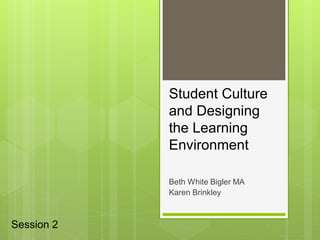
Ut students millenials learning preferences
- 1. Student Culture and Designing the Learning Environment Beth White Bigler MA Karen Brinkley Session 2
- 2. Understanding Our Students How Student Statistics Explain Learning Successes and Challenges at the University of Tennessee
- 3. PRESENTATION OVERVIEW Millennials 2012-2013 Freshman Class Adult Learners Student Motivation UT Student Survey Conclusion
- 4. Millennials Born 1982-2002 Exceptional Technology Skills 70-95 Million People 30% of the Population Confident and Optimistic 34% Minority Self-Expressive Open to Change Sheltered Pressured to Succeed Achievement-Focused Extrinsically Motivated Source: “The Millennials: Confident, Connected and Open to Change.” (2012). Pew Research Center Source: Howe and Strauss (2003). “Millennials Go to College.”
- 5. 2012-2013 Freshman Class 4200 Students 89% In-State 19% Minority Average GPA: 3.89 27 ACT Score Mean Family Income: $125,000 99% Qualify for HOPE Student qualifications are in-line with the “Top-25” Research Universities
- 6. Adult and Non-Traditional Learners More experience & prior knowledge Intrinsically motivated Responsibilities or challenges that can interfere with the learning process Adults learn differently ◦ Prefer active learning & practical application ◦ May be less comfortable with technology Source: Bash, L. (1999). Adult learners in the academy. Indianapolis, IN: Josey-Bass. Source: Cercone, K. (2008). Characteristics of adult learners with implications for online learning design, AACE Journal, 16(2), 137-159.
- 7. Student Motivations 1. Self: 4. Method & Process ◦ Extrinsic vs. Intrinsic ◦ Encouragement and ◦ Individual and Social Praise Factors ◦ Guided Discussion ◦ Values 5. Environment 2. Instructor: ◦ Structure ◦ Passion for Material ◦ Emotionally-literate ◦ Caring for Students 3. Content: ◦ Shared Responsibility ◦ Co-Creation of Value Source: Williams, K.C. and Williams, C.C. (2011). Five key ingredients for improving student motivation. Research in Higher Education Journal, (12): 1-23
- 8. Student Success Students who leave Orientation UT: The Top 6 Reasons 83% thought earning As and Didn’t fit in Bs in high school was Difficulty adjusting to UT “Somewhat Easy” Financial Reasons 68.5% spent less than one Campus is too large and hour each day on impersonal homework Too far from home / homesick Too much pressure / stress UT Student Survey Results
- 9. Conclusions Most students will be performance-oriented Many of the bright and more motivated students want to “own” their education and be involved in the decision-making Students will likely experience a “learning adjustment” when compared to high school Practicing effective teaching can reach all students Responsibility rests with the student
- 10. Questions? UT Students Working Together
- 12. Index of Learning Styles Developed in 1991 by Richard Felder and Barbara Solomon (NCSU) 44 question instrument designed to assess preferences on the four dimensions of the Felder -Silverman model (1988) Designed for engineering students
- 13. Identifying Your Learning Preference 11 9 7 5 3 1 1 3 5 7 9 11 Four dimensions: Sensing/Intuitive Visual/Verbal Active/Reflective Sequential/Global
- 14. Sensing - Intuitive Sensing Intuitive Like learning facts and Often prefer discovering solving problems using possibilities and well-established methods relationships Tend to be patient with Like innovation NOT details and good at repetition memorization Tend to work faster than Don’t like courses with sensors no apparent connection Don’t like courses that to the real world require a lot of Like doing hands-on memorization work
- 15. Visual - Verbal Visual Learners Verbal Learners Prefer explanations with Prefer written and spoken many charts, graphs, explanations pictures, etc. Have difficulty in classes were information is presented mostly through lectures and written material
- 16. Global - Sequential Global Learners Sequential Learners Tend to learn in large Tend to follow logical step jumps, they may begin by step paths to find slowly and then make solutions large leaps Learn in small May be able to solve and incremental steps synthesize complex Make steady progress problems Easily explain and Can see the “big picture” analyze but may have difficulty explaining how they did it
- 17. Active - Reflective Active Learners Reflective Learners Learn by trying things out Learn by thinking things Tend to like group work through Lecture style teaching is Tend to prefer working difficult for active learners alone Lecture style teaching is also hard for reflective learners
- 18. Does it Really Matter? Students have different Teachers have different strengths and strengths and preferences in the ways preferences in the ways in which they take in or they present materials process information
- 19. In the Conflicted Space Students are likely to: Be inattentive, passive learners Become discouraged about the course Do poorly on tests Change majors Professors are likely to: Become inattentive Become discouraged Become hostile Become apathetic and ineffective
- 20. Ask The Experts: Please take a few minutes to think of a question or two about teaching or learning you would like the students to address. Write it on one of the index cards in the center of your table.
- 21. Where Do We Go From Here? Vary the sources of information Vary instructional strategies Vary evaluation/assessment methods